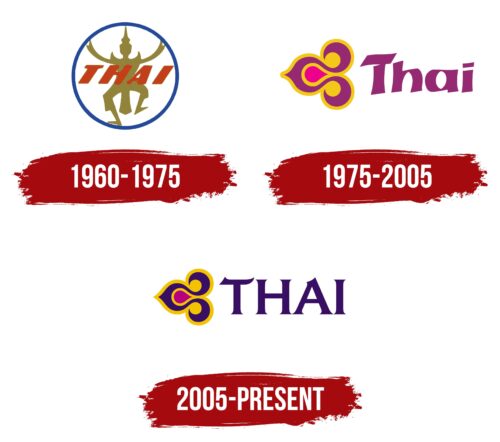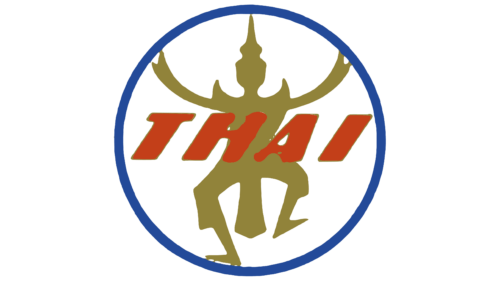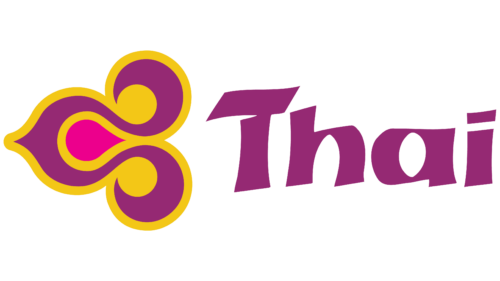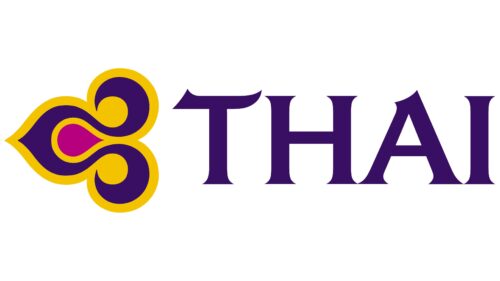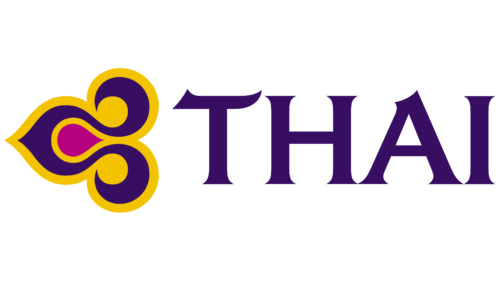 Thai Airways International Logo PNG
Thai Airways International Logo PNG
At first glance, the Thai Airways International logo emphasizes the airline’s high status and professionalism. The designers infused it with much more:
- A reflection of Thailand’s elegance and culture
- A symbol of hospitality
- A connection to local traditions
All of this is meant to showcase the company’s authenticity.
Thai Airways International: Brand overview
Thai Airways International, Thailand’s flag carrier, began its illustrious journey on May 1, 1960. The airline was born out of a partnership between Thai Airways Company (TAC), Thailand’s domestic airline, and Scandinavian Airlines System (SAS), with SAS holding a 30% stake and providing technical expertise during the fledgling years.
The airline’s inaugural international flight took off on May 1, 1960, connecting Bangkok to Hong Kong. Throughout the 1960s, the aviation operator expanded its network, establishing routes to other Asian countries, Australia, and Europe.
By 1971, the brand had bought out SAS’s shares, becoming wholly owned by Thai interests. In 1975, a significant milestone was achieved when the airline merged with Thai Airways Company, consolidating under Thai Airways International’s single brand and becoming Thailand’s sole national carrier.
The acquisition of their first Boeing 747 in 1977 marked the beginning of an era of growth. This wide-body aircraft enabled the company to increase capacity and expand its long-haul network. The 1980s saw continued expansion, with the airliner launching services to North America and boosting frequency to European destinations.
1991, the company went public, listing its shares on the Thailand Stock Exchange. Despite facing severe financial challenges during the Asian financial crisis in 1997, the air operator managed to navigate through with the government’s support and a thorough restructuring process.
Entering the new millennium, the aviation firm embarked on an extensive fleet modernization program, acquiring new Airbus and Boeing aircraft to replace older models. In 2005, the airline became a full member of Star Alliance, enhancing its global reach and connectivity.
The company launched Thai Smile in 2011, a subsidiary focused on short-haul routes to cater to regional travel and compete with low-cost carriers. Between 2012 and 2013, the brand undertook a significant service enhancement program, refurbishing cabin interiors and upgrading in-flight services.
Financial struggles resurfaced in 2014 due to intense competition and political instability in Thailand. The aviation firm initiated another restructuring plan to reduce costs and improve operational efficiency. This effort continued from 2015 to 2019, focusing on optimizing the route network and fleet composition.
As the 2020s unfold, the air operator is dedicated to overcoming modern challenges and enhancing its financial health. The company remains focused on maintaining its status as a leading carrier in Southeast Asia and adapting to the aviation industry’s ever-evolving conditions.
Meaning and History
What is Thai Airways International?
This is the national carrier of Thailand, based in Bangkok, known for its unique Thai hospitality and role as an “ambassador” of Thai culture worldwide. The company operates a diverse fleet of wide-body aircraft, including Airbus A350 and Boeing 787 Dreamliner, allowing it to serve an extensive network of international routes. The company’s uniqueness lies in its Royal Orchid Spa program, offering first and business-class passengers complimentary spa treatments at Suvarnabhumi Airport.
1960 – 1975
At dawn, the airline operated flights only to Asian countries, so its original logo was familiar and understandable to most passengers. It depicted a unique image—a Thai dancer in traditional attire. This reflects Thailand’s cultural heritage, associated with elegance, lightness, and grace. It symbolizes hospitality, cultural richness, and beauty, which the brand strives to convey to its customers.
The dancer’s silhouette is not detailed; only some costume elements can be identified by its general outlines. The most recognizable of them is the chada—a tall headdress with a characteristic pointed top. In Thailand, it symbolizes power, although theater actors often use it. Since Thai Airways International was initially established as a regional company, it was proud of local traditions and highlighted its connection to its home country—even through an authentic logo.
The dancer is entirely painted in dark gold. This refers to national costumes, many decorated with gold threads and precious stones. In the context of air transportation, gold symbolizes royal comfort and the highest level of service. The silhouette is placed in a blue circle, the color of which is associated with the endless sky and freedom.
Across the dancer, the word “THAI” is written in large red letters. Aviation enthusiasts will surely recognize its bold italic font, as the logo of the Scandinavian Airlines System features the same style. This is because, since 1960, the Scandinavian company has owned a share of the Thai brand, explaining the similarity in their identities. The red color reflects the brightness of national costumes and emphasizes the swiftness of flying airplanes.
1975 – 2005
In the 1970s, the company began operating intercontinental flights. Since Thai Airways International planes now flew to distant countries unfamiliar with Asian culture, the old logo featuring the dancer was no longer suitable—foreign clients simply didn’t understand its meaning. Therefore, the brand had to replace it with a neutral symbol that all passengers would intuitively understand. The airline maintained an invisible connection to local traditions even in this situation.
The new emblem features a curved figure with elegant spirals at the ends. It is inspired by several elements of the country’s culture and history:
- The smooth lines resemble flowing silk, an ancient Thai craft unmatched throughout Asia.
- The emblem’s shape is similar to that of a tropical orchid flower. The local climate is perfect for this luxurious plant.
- The abstract pattern imitates traditional Thai artistic motifs. It is a reflection of classical art.
The one small visual element became an icon of the entire nation, not just the airline. It symbolizes Thai Airways International’s close connection to its homeland and proudly represents it internationally.
The colors of the logo carry hidden meanings:
- Purple symbolizes luxury and innovation.
- Gold alludes to Thailand’s golden temples.
- Dark pink is the color of tropical orchids.
The word “Thai” is written in a modern font with an Asian style. The diagonal strokes at the ends of the letters make the word uneven and dynamic, conveying the airline’s vibrant energy. This emblem serves two purposes: it showcases the brand’s national character and creates an international image.
2005 – today
In 2005, the logo was transformed but retained its authenticity. It still features an elegant pattern with curved ends associated with flowing silk and the orchid flower. Only the color scheme changed: gold became yellow, purple turned blue, and pink acquired a darker shade. This innovation made the emblem more expressive and versatile.
The lettering was changed to uppercase, reflecting the airline’s confidence and growing potential. The font now resembles a classic serif with triangular serifs but has some unique features. The top of the “A” has a semicircular indentation, and the horizontal stroke of the “T” resembles an element of Thai temple architecture. Behind the word “THAI,” there is more than just a brand name. It symbolizes a deep connection with traditional values and is an authentic style icon.
Initially, the logo was three-dimensional, with a gradient texture. 2018, it adopted a flat, two-dimensional version, ultimately becoming the primary one. This simplification demonstrated that Thai Airways International aims to create a modern, minimalist image to expand its influence in many Western countries.
